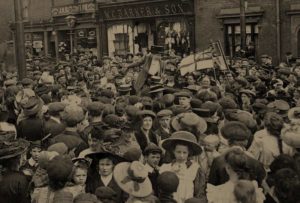
Mary MacArthur, Chainmakers’ Lockout, Cradley Heath. 1910.
A striking feature of the chainmakers’ dispute is the astute media campaign orchestrated by Mary Macarthur. She secured coverage not only in long established papers like The Times, the Daily News and Reynolds’s Newspaper but in the relatively new mass circulation papers such as the Daily Express (founded 1900), and the Daily Mail (founded 1896).
Some of the stories were accompanied by photos of the women chainmakers. It was only 13 years previously that the first half-tone photos had appeared in newspapers. Even more astonishing is how she harnessed the power of the moving image. It was only two months before the strike, in June 1910, that the first ever British newsreel was shown, the weekly Pathé’s Animated Gazette, but Mary was quick to see the possibilities for publicising the chainmakers’ cause to a mass audience.
In September 1910 a Pathé newsreel film vividly depicted the arduous nature of the women’s work. A scene in which children are playing around the forge was followed by a procession of the women, accompanied by a large crowd of sympathisers, marching down the streets. The manager of Pathé estimated that the film was seen by 10 million people throughout the country. The film is, sadly, now lost. It depicted the employers as the villains of the piece and an outraged nation rallied to the chainmakers. Thanks in large part to the media campaign, money flooded into the strike fund to sustain the strikers until the third week in October 1910 when the last employer agreed to pay the new rates.